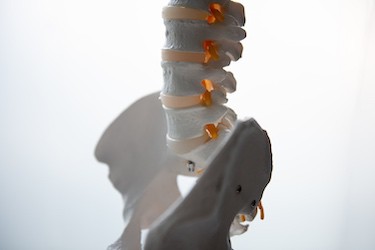What Is Lumbar Decompression Surgery?
The entire aim of lumbar decompression surgery is to reduce pressure on the spinal cord to relieve chronic pain in the life of the individual undergoing the procedure. There are three primary ways in which a surgeon might attempt to provide this reprieve to their patient.
- Laminectomy (or laminotomy, based upon the opinion and expertise of the lead surgeon) – This specific surgery involves removing a section of one of your vertebrae in order to allow relief from the constant pressure causing your pain. In the case of the laminotomy, a hole is drilled in lieu of actually removing a portion. Both of these methods of treatment have shown success in reducing lumbar pain for patients.
- Spinal Fusion – Sometimes, it is necessary for neurosurgeons to actually couple two or more vertebrae together in order to allow for a more fortified and stable spinal column.
- Discectomy – In many cases, the problem that needs to be addressed in order to alleviate pain is simply to remove or repair a disc that has become damaged. This seemingly small action can promise fast relief for those in chronic pain.
Who Are Good Candidates to Undergo This Procedure?
Individuals who have been most benefited from lumbar decompression surgery are those who experience debilitating pain and sometimes even numbness in the lower back and legs related to a large pressure buildup in their lumbar spine. There are several conditions of the spine and back which might call for this type of surgical treatment.
Injured Spine – Those who have sustained an injury to the spine that causes them persistent pain in the aftermath might find that lumbar decompression surgery is able to reduce the burden they feel.
- Sciatica – Individuals who suffer from sciatica pain will generally feel discomfort starting in their lower back which then radiates out to their legs. Sometimes, sciatica can even cause the person to find it difficult to stand up straight. For these reasons, they might find that they are ready to embrace a surgical option to spinal treatment.
- Cancer – When cancer has the opportunity to metastasize to the spinal cord, these tumors and cells can cause pressure on the lumbar spine, which will tend to be painful.
- Spinal Stenosis – This condition refers to a process of a particular piece of the spinal column narrowing in a way many will find painful. This is generally because the nerves and tissue inside are compressed and agitated. Lumbar decompression surgery can provide effective treatment for spinal stenosis.
What Sort of Relief Can It Provide?
Decompression is known to produce results that patients will notice nearly immediately following the procedure. Most patients undergo this type of procedure with an expectation of dramatic relief of their symptoms, and most report that the difficulties they had in walking and general mobility, as well as their pain level, were markedly different as soon as their surgery was over and they were back on their feet. This is not to say that rehabilitation will not be necessary to fully solve these compression problems that exist in the spine, but it does mean that results from lumbar decompression surgery are quite promising.
Who Performs Lumbar Decompression Surgeries?
An experienced neurosurgeon will be the physician who will perform this procedure for you. Their extensive knowledge of the spinal and nervous system allows them to make small scale modifications to your spinal column in order to bring about relief. You will likely be referred to an orthopedist or a physical therapist who will oversee your rehabilitation following your surgery. Physiotherapy is a vital element in the overall success of the lumbar decompression surgery because it will help to acclimate your body to the changes that have been made.
Are There Any Risks Associated with Lumbar Decompression Surgery?
As with any surgery, there are risks to be noted. Any time an incision is made, no matter how small, there is a small risk that the patient will contract an infection while their body is open to potential bacteria. Spinal surgery carries the risk of damage to the spine, which can mean any number of things result in the days and weeks following the original surgery. Continued symptoms, pain and weakness, and even more serious spinal issues are possible, but not probable in the course of lumbar decompression surgery. Blood clots can also occur after the surgery has been completed. The procedure is considered to be safe and beneficial to those who seek it out to relieve their pain and lack of mobility. With that in mind, this type of surgery should only be performed on individuals who have exhausted their non-surgical options to treat their pain.

 Injured Spine – Those who have sustained an
Injured Spine – Those who have sustained an